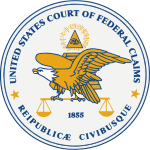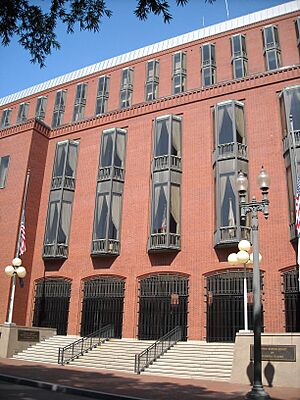United States Court of Federal Claims facts for kids
Quick facts for kids United States Court of Federal Claims |
|
|---|---|
| (Fed. Cl.) | |
 |
|
| Location | Howard T. Markey National Courts Building |
| Appeals to | Federal Circuit |
| Established | 1982 (predecessor court established in 1855) |
| Authority | Article I tribunal |
| Created by | Federal Courts Improvement Act 28 U.S.C. §§ 1491–1509 |
| Composition method | Presidential nomination with Senate advice and consent |
| Judges | 16 |
| Judge term length | 15 years |
| Chief Judge | Elaine D. Kaplan |
The United States Court of Federal Claims (often called Fed. Cl. or C.F.C. in legal documents) is a special U.S. federal court. It handles money-related lawsuits against the U.S. government. This court was created in 1982, but its history goes back to 1855.
The court's building is the Howard T. Markey National Courts Building. It is located in Washington, D.C., right across from the White House.
Contents
How the Court of Federal Claims Began
The Court of Federal Claims has a long history. It started as the United States Court of Claims in 1855. Congress created it to let people make claims for money against the U.S. government. President Franklin Pierce signed the law that created it.
For over 160 years, the court's main goal has stayed the same. It allows citizens to sue the federal government for money. Because of this, some people call it the "keeper of the nation's conscience" or "the People's Court."
When it first started, the court couldn't make final decisions. This changed in 1866. President Abraham Lincoln believed the government should provide justice to its citizens. He said it was just as important as justice between private people.
In 1887, the Tucker Act greatly expanded what the court could hear. Today, the court hears most money claims against the government. It does not use juries. Instead, a judge decides the facts and the law.
The court handles many types of cases. These include claims for:
- Fair payment when the government takes private property.
- Refunds of federal taxes.
- Military and civilian pay issues.
- Money for broken contracts with the government.
- Cases about patent and copyright infringement by the U.S. government.
- Lawsuits from Native American tribes.
The court also hears cases from companies that lose out on government contracts. These are called "bid protest" suits.
A special part of the court's job is handling "congressional references." This means Congress can ask the court to look into a bill. This bill might be about paying someone for a claim. A judge will investigate and then a panel of three judges sends a report back to Congress.
The court has always been in Washington, D.C.. It has been near the White House or in the U.S. Capitol Building. It moved into its current home in 1967. This building is at 717 Madison Place, NW.
The court started with three judges. Over time, more judges were added. By 1977, it had 16 trial judges. These judges would hear cases first. Money awarded by the court is paid by Congress. In 1977, Congress set up a permanent way to pay all judgments from the court.
The Court Today
The Federal Courts Improvement Act of 1982 created the modern court. The trial part of the old Court of Claims became the United States Claims Court. In 1992, its name changed to the United States Court of Federal Claims.
If someone disagrees with a decision from this court, they can appeal. The appeal goes to the United States Court of Appeals for the Federal Circuit. After that, the case can only go to the Supreme Court if they choose to review it.
Today, the court has 16 judges. The President appoints these judges. The Senate must approve them. They serve for 15-year terms. Judges who finish their terms can continue to work on cases as senior judges. This helps keep the court fair and independent.
In recent years, the court has handled many big and important cases. These include:
- Cases from the savings and loan crisis in the 1980s.
- Cases about the internment of Japanese-Americans during World War II.
- Cases about the government's storage of nuclear waste.
No matter the case, the court helps the government settle with those it has legally wronged. It helps make sure the government follows the law. It also supports the First Amendment right to "petition the Government for redress of grievances." This means people have the right to ask the government to fix problems.
In 1986, the National Childhood Vaccine Injury Act gave the court a new role. It created an Office of Special Masters. This office hears cases about vaccine injuries. The court reviews these cases. This part of the court's job has grown to include claims from many different vaccines.
The court is now the only place where companies can challenge government contract decisions after a contract has been awarded.
In 2006, the court made decisions in over 900 cases. It awarded $1.8 billion in damages.
What the Court Hears
The court has special jurisdiction. This means it can only hear certain types of cases. It hears claims for money damages. These claims must come from the U.S. Constitution, federal laws, government rules, or a contract with the U.S. Government. The most important law for this is the Tucker Act.
The court can hear cases about claims less than $10,000. For these smaller claims, people can also go to a U.S. district court.
There is a time limit for filing claims. You must file within six years from when the problem first happened. The court is very strict about this time limit.
The court also handles disputes about contracts with the federal government. A contractor can choose to sue the court or the agency's Board of Contract Appeals. They must choose one place to file their lawsuit.
Unlike district courts, which usually only hear cases in their local area, this court can hear cases from anywhere in the country. To make it easier for people, judges might hold trials in local courthouses.
All trials in this court are bench trials. This means a judge hears the case, not a jury. Since the court only hears cases against the government, the United States is always the defendant.
The court hears many different types of claims against the government:
- Claims for breach of contract (when a contract is broken).
- Claims for illegal payments taken by the government.
- Claims that the government took private property without fair payment (under the 5th Amendment).
- Claims about military pay.
- Claims for patent and copyright infringement by the government.
- Federal tax refund claims.
- Protests about how government contracts were bid.
Tax refund lawsuits make up about a quarter of the cases here.
Decisions from this court can be appealed. The appeals go to the United States Court of Appeals for the Federal Circuit. This court is in the same building.
This court does not hear claims under the Federal Tort Claims Act. Those cases go to a United States district court.
How Judges Are Chosen
Judges on the Court of Federal Claims do not serve for life. Instead, they serve for 15-year terms. They can be reappointed. The President chooses the judges. The Senate must approve them.
These judges can be removed from their positions. This can happen if they are found to be incompetent, misbehave, neglect their duties, practice law, or have a physical or mental disability. The U.S. Court of Appeals for the Federal Circuit makes this decision.
Current Judges
As of 2022, the Chief Judge is Elaine D. Kaplan. She was appointed by President Barack Obama as a judge and by President Joe Biden as Chief Judge.
There are 16 judges on the court. Many judges have been appointed by Presidents Donald Trump and Joe Biden.
Some judges who have completed their 15-year terms can become "Senior Judges." They can still hear cases. This helps the court manage its workload.
Chief Judges Through History
- Alex Kozinski: 1982–1985
- Loren A. Smith: 1986–2000
- Lawrence M. Baskir: 2000–2002
- Edward J. Damich: 2002–2009
- Emily C. Hewitt: 2009–2013
- Patricia E. Campbell-Smith: 2013–2017
- Susan G. Braden: 2017–2018
- Margaret M. Sweeney: 2018–2020
- Eleni M. Roumel: 2020–2021
- Elaine D. Kaplan: 2021–present


